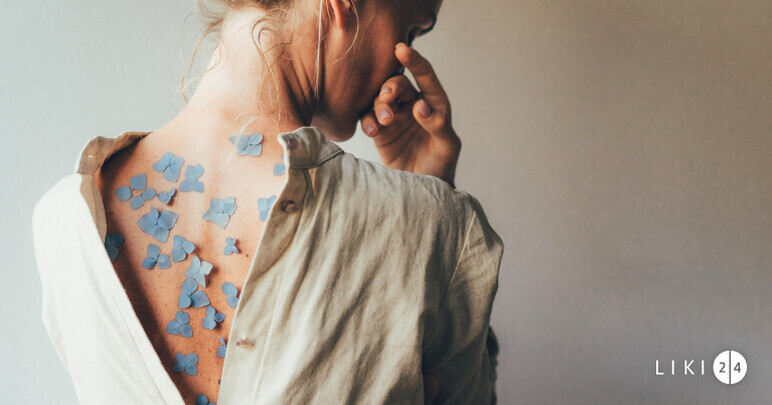Aproximativ 2% din populație sunt afectați de această afecțiune inflamatorie cronică, ajungând la 11% pentru populația scandinavă și caucaziană. Este o patologie care poate să apară la orice vârstă și afectează atât bărbații cât și femeile. Apare mai frecvent în decada a 3-a de viață.
Factorii care au fost asociați cu apariția psoriazisului sunt obezitatea, stresul, consumul de alcool, fumatul, infecțiile virale, amigdalita streptococică, precum și anumite medicamente precum beta-blocantele (utilizate în tratamentul hipertensiunii arteriale). În aproximativ o treime din cazuri, factorul genetic poate conduce la o problemă imunitară. Deseori, în familia persoanelor cu psoriazis, întâlnim și alți membri cu această maladie.
Se întâlnesc cele mai variate zone ale corpului afectate de psoriazis, respectiv având simptome ușor diferite.
Ce este psoriazisul?
Psoriazisul reprezintă afecțiune dermatologică cronică, determinată de înmulțirea anormală a celulelor la nivelul pielii, care în forma mai avansată a bolii determină formarea unor plăci groase tegumentare, acoperite de scuame albicioase.
Ca să înțelegem mai bine, celulele din stratul epidermei se maturizează și cresc în aproximativ 28-30 de zile. În psoriazis acest timp de creștere poate să ajungă la 2-3 zile pentru leziunile specifice, întrucât procesul de diviziune celulară poate să fie de 15 ori mai rapid.
În dependență de o mulțime de factori și criterii, leziunile variază ca aspect – în funcție de sexul persoanei, vârstă, localizarea primei crize etc.
Din păcate, la aproximativ 80 % din persoanele care suferă de această maladie, plăcile de psoriaz se pot irita și infecta.
Dacă pacientul nu urmează tratament, aceste leziuni capătă o structură de piele solzoasă și groasă. În timp acestea se pot colora în nuanțe de argintiu, alb sau roșu aprins.
Aceste plăci se pot dezvolta oriunde pe corp, însă cele mai frecvente sunt zone de psoriaz al scalpului, genunchi, coate și psoriaz unghial.
Psoriazisul unghial afectează aproximativ 50 % dintre pacienții care dezvoltă psoriazis.Dacă unghiile dezvoltă coroziuni, încep să se îndepărteze de la patul unghial sau dacă își modifică culoarea într-o nuanță galbenă – portocalie, poate fi simptom de artrita psoriazică.
Psoriazis cauze
Progresul geneticii și avântul tehnologic din păcate nu ne oferă informație deplină referitor la cauzele psoriazisului. De la factorul genetic, stilul de viață, alimentație, stres, există o mulțime de factori intrinseci și extrinseci care pot declanșa psoriazisul. Toți pacienții cu psoriazis au în comun unele aspecte, precum tulburări imunologice, hormonale și metabolice.
S-a reușit totuși să se grupeze cei mai importanți factori declanșatori ai psoriazisului sau elemente cu risc incipient crescut pentru această maladie de piele.
- anxietatea, stresul pot declanșa și menține boala, dar riscul crește odată cu vârsta, cel mai predispus segment fiind între 30-45 de ani;
- factorii infecțioși: infecțiile din sfera ORL (sinuzitele,amigdalite, otite cronice) pot genera un teren propice pentru declanșarea psoriazisului și perturba funcția sistemului imunitar, mai ales la copii, în aproximativ 30 % de cazuri;
- fumatul și alcoolul influențează negativ evoluția bolii, la fumători și alcoolici existând forme mai severe ale bolii;
- climatul uscate și rece (incidența psoriazisului este mai ridicată în țările nordice);
- traumatismele mici, în special cele de la nivelul periunghial, în urma unei pedichiure și manichiure agresive, pot întreține boala;
Psoriazis simptome
- Plăci de culoare roșie, bine delimitate, acoperite de scuame sidefii, care apar simetric, cu precădere în anumite zone – genunchi, coate, nivelul scalpului, interfesier, uneori pe brațe, trunchi și picioare;
- Piele uscată, cu mâncărimi, crăpată, care poate sângera;
- Numeroase pete scuamoase, mici, de culoare roșie, răspândite pe brațe și picioare (psoriazis gutat);
- Zone de piele pline de pustule sau coșuri (psoriazis pustulos);
- Zone netede de piele inflamată, roșie, la nivelul pliurilor axilelor, fese, în zona inghinală, sub sâni și în zona genitală (psoriazis inversat);
- Unghii crestate, îngroșate, cu adâncituri punctiforme;
Tipuri de psoriaz
În funcție de localizare și vârstă, deosebim diferite forme clinice ale bolii. Uneori boala poate conduce la apariția unor blocaje severe la nivelul articulațiilor și genera forme grave. Poate duce chiar la deces din cauza infecțiilor și complicațiilor care apar pe suprafața pielii.
Psoriazis gutos
Apare mai frecvent la grupa de vârstă sub 30 de ani. Se caracterizează prin apariția unor papule sub formă de picături de apă pe brațe, trunchi, scalp și picioare.
Psoriazis pustulos
Tip rar de psoriazis care se caracterizează prin apariția unor pete care cuprind zone mici cum ar fi mâinile, picioarele, sau se răspândesc pe zone mai mari de corp.
Psoriazisul inversat
Tipul de psoriaz care afectează preponderent zona genitală, pielea de la subraț și sub sâni. Acest tip de psoriaz se întâlnește mai frecvent la persoanele supraponderale și este agravat de transpirație și fricțiuni.
Psoriazisul eritrodermic
Cel mai rar tip de psoriazis. Arsurile solare reprezintă de obicei factorul declanșator.
Artrita psoriazică
Artrita psoriazică cauzează denivelarea și decolorarea unghiilor, inflamarea articulațiilor, care devin dureroase. Are foarte multe în comun cu artrita, dar implică și decolorări nesănătoase și apariția unor formațiuni în anumite zone ale corpului.
Psoriazis la copii
Psoriazisul poate afecta copii începând cu perioada de nou-născut. Poate debuta de la 3 luni, cu afectarea zonei scutecului și se poate extinde cu papule eritematoase. La copii apar leziuni și la nivelul feței, spre deosebire de psoriazis la adulți.
Diagnosticul
Ce analize se fac pentru psoriazis?
În mare parte, un medic dermatolog cu experiență, poate recunoaște leziunile tipice caracteristice pentru psoriaz, fără a efectua analize suplimentare. În cazul psoriazisului cronic grav, neresponsiv la tratament, poate fi necesară biopsia leziunii – pentru inițierea tratamentului biologic sau pentru excluderea altor afecțiuni, în cazul formelor atipice.
Psoriazis tratament
Fiind o boală cronică, care frecvent recidivează, psoriazis necesită tratament pe termen lung.Tratamentul pentru psoriazis are drept scop încetinirea creșterii celulare, reducerea inflamației locale și îndepărtarea plăcilor cutanate deja formate.
Deosebim mai multe tipuri de tratament în psoriazis:
- Tratament topic
- Medicație sistemică
- Terapie prin lumină
- Tratamentul topic
Este reprezentat de creme pentru psoriaz și unguente pentru psoriaz care se aplică pe piele. Sunt utilizate în formele ușoare și medii de boală, putând determina chiar o aparentă vindecare de psoriaz.
De exemplu Xemose, Psoriane, Keratosane 30.
De asemenea sunt utilizate și unguente cu retinoizi, corticosteroizi, acid salicic.
Medicație sistemică
Pacienții cu formele medii și severe de boală, care nu răspund la tratamentul topic pentru psoriaz, vor avea nevoie de medicație pe cale orală. Aceste medicamente au efecte adverse în marea majoritatea, de aceea se pot administra doar la recomandarea medicului. Din acestea fac parte : metotrexat, ciclosporine, retinoizi pe cale orală.
Terapie cu lumină
Terapia cu lumină utilizează lămpi UV speciale cât și lumina naturală. Lumina solară are proprietatea de a inactiva leucocitele hiperactive ce atacă celulele sănătoase din piele și conduc la replicarea lor haotică.
Boala trebuie ținută sub control pe parcursul întregii vieți, unii fac acest lucru utilizând același tratament, pe când alții sunt nevoiți să varieze metodele de tratament.
Psoriazis tratament naturist
Regimul alimentar neechilibrat nu poate influența apariția psoriazisului, dar adoptarea unei diete sănătoase este destul de benefică. Sunt contraindicate în psoriazis condimentele iute, întrucât exacerbează simptomele bolii și mențin inflamația din corp. Este bine de evitat consumul de alcool, fumatul, traumatizarea și instalarea obezității. Este necesară reducerea nivelului de anxietate, stres, furie, căci psoriazisul tinde să se inflameze în stres psihic și fizic.
Psoriazisul este o patologie cutanată multifactorială cronică, cu puternic impact asupra calității vieții pacienților, care necesită o abordare atentă și o bună interacțiune între pacient și medicul dermatolog pentru a atinge acel scop comun, perioade cât mai lungi fără recăderi.



 Wellness
Wellness  Fitness
Fitness  Nutriție
Nutriție  Frumusețe
Frumusețe  Frumusețe
Frumusețe  236 de vizualizări
236 de vizualizări 




 Articolul Anterior
Articolul Anterior 







